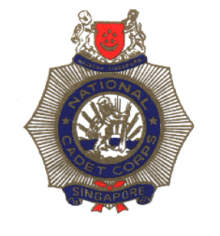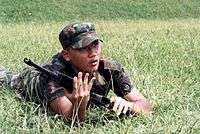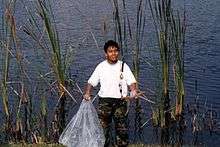National Cadet Corps (Singapore)
| National Cadet Corps | |
|---|---|
 | |
| Active | 1901 |
| Country | Singapore |
| Branch | Air, Sea and Land |
| Garrison/HQ | Amoy Quee Camp |
| Nickname(s) | NCC |
| Motto(s) | "To serve with Pride and Dedication" |
| Anniversaries | 115th |
| Website | www.ncc.org.sg |
| Commanders | |
| Commandant | LTC Richard Koh Ban Chuan |
| Insignia | |
| Identification symbol | NCC Formation Patch and NCC Arms Badges |
The National Cadet Corps (NCC) is a military cadet corps youth organisation supported by the Singapore Ministry of Defence and the Ministry of Education. As of December 2015, it had a total strength of 18'000+ members. This consists of 823 Officers, 407 Cadet Officers and 14500 cadets, amongst others.The NCC is represented in Secondary Schools and there are a total 176 School Units-137 Land Units, 17 Sea Units and 18 Air Units.
Activities
Within the framework of the training programme NCC cadets have the opportunity of taking part in many activities.

Training Days
Every unit meets or parades, at least once a week. Training Days usually begin and end with a simple parade. The parade at the start of training is usually used for taking attendance and briefing cadets on the schedule for the days training session while the parade at the end of training is used to brief cadets on subsequent events and as a short feedback session. A typical training day might include Physical Training, Drills and lessons on topics such as Fieldcraft, Navigation and other military-related topics.
Physical Training
PT usually starts with a short warm-up, then a few sets of static stations before the whole unit goes for a company run. Physical fitness is a criterion for the Best Unit Competition. It has also been added as a graded component for courses.
Technical Handling
Before cadets are allowed to handle the rifle, cadets have to go through a trainfire package. In the package, lessons conducted by NCC personnel who have attained the Army/RSN/RSAF-NCC badge who are certified as SAF trainfire instructors include stripping and assembly, marksmanship fundamentals, stoppages and remedies and finally loading and unloading. Cadets can be trained to be proficient to a degree that stripping and assembling the rifle in blindfold or one hand.
Marksmanship
Cadets have the opportunity of firing a SAR 21 rifle on firing ranges. Cadets first train on the Individual Marksmanship Trainer (IMT), a computerised simulation, before progressing on to shoot at live firing ranges. Safety is always the main concern when shooting, with everything done by the book. Cadet live firing is always conducted by active armed forces personnel under the supervision of a trained Safety Officer. An armed forces Medic is also attached as a safety measure.
A Shooting Competition is also organised annually where cadets from all three services (Land, Sea and Air) compete.
Cadets who obtain a respectable shooting score are awarded a Marksmanship badge.

Drill
All NCC units (Land)/squadrons (Air & Sea) practice drill as a means of instilling discipline and teamwork, it is also used in formal parades, for moving around military bases and moving cadets in a smart and orderly fashion.
Cadets and Cadet Officers who possess a high standard of military drill may be given Parade Appointments such as Colours Ensign, Parade Regimental Sergeant Major, Colours Regimental Sergeant Major and Armed Escort. This group is given further drill training and compose the Guard-of-Honour contingent who greet visiting dignitaries.
Certain units also form Precision Drill Squad which specialise in performing display drills and the newly introduced Freestyle Drill teams.

Adventure Training
Junior Cadets (Secondary 1 cadets) attend an outdoor camp for at least 2 nights and 3 days conducted by their school's unit. From 2008 onwards, they will also attend Camp FORGE, an adventure-based experiential day camp held in NCC Campus. The acronym FORGE, stands for Fun, Orientation, Resilience-Building, Group Dynamics (Social Gelling and Bonding) and Experiential Learning. Cadets are given opportunities to participate in activities such as archery, paint-ball gun competition and the Flying Fox, amongst many adventure facilities. (Secondary 2 cadets) Senior Cadets, until 2008, will attend Camp FEAST. From 2014 onwards Junior cadets attend Camp FORGE. Senior cadets have a new camp to attend. This new camp, since 2009, is termed Camp STEEL. This stands for Standards, Tenacity, Emotional Intelligence, Energy and Leadership. This is a 2 Day residential camp during which cadets participate in more challenging adventure training like the Rappelling Wall, Advanced Paintball Challenge, Weapons Technical Handling, Team Building and Team Learning, and basic Emotional Intelligence knowledge. All these serve to provide cadets with tools to become better leaders-both of themselves and of their peers and juniors.
Cadet Leaders (Secondary 3 cadets) will undergo their marksmanship test,before they get a chance to fire the live rounds.
Cadet Leaders will also be sent for the Specialist Assessment , where they undergo training and tests and will eventually pass out as a 3rd Sergeant.
Cadets who performed well will be selected to attend a further training course known as the Senior Specialist Course, where they will undergo trainings and test and eventually pass out as Staff Sergeants (SSG). Cadets will also be rewarded with a red lanyard which can be worn round their shoulders while they are in uniform.
From 2009 onwards , a Cadet Leader from each unit will also attend the Advanced Drill Course, which will enable them to learn advanced drills not taught normally in their syllabus. Upon graduation, cadets will be rewarded with a yellow lanyard which can be worn round their left shoulder.
Cadets are also provided many opportunities to attend adventure courses locally and overseas. The following are some of the courses available:
- Outward Bound Course in Singapore
- Annual Kayaking Expedition
- Mount Ophir Expedition
- Endau Rompin Expedition
- Outward Bound Course in Sabah/ Brunei
- Desert Trekking in India
- Glider Course in India
- Jungle Training Course in Brunei
In addition to the above, the SAF also supports the NCC in getting selected NCC cadets to experience SAF Overseas Training during the various SAF Exercises. For example, selected NCC cadets are provided opportunities to observe the SAF training during the following Exercises and countries: Exercise ThunderWarrior-New Zealand Exercise Wallaby-Australia Exercise BattleKing-Thailand Exercise PanzerStrike-Germany (scheduled in 2011)
Other opportunities include: Pearce Air Base Visit (Australia) Midshipman Sea Training Deployment (MSTD)
NCC cadets are also able to attend prestigious courses such as the Basic Airborne Course and Basic Diving Course conducted by the SAF Commandos and RSN Naval Diving Unit respectively. Upon graduation, graduands will be award the SAF Basic Airborne Wing and Basic Diving badge. The Engineer-NCC Experiential Camp is another opportunity to expose the cadets to the SAF training environment.
Currently, there is an array of 17 different types of adventure trainings offered to cadets both locally and overseas as compared to 21 similar adventure trainings worldwide. The NCC is constantly seeking new adventure programmes to broaden the experiences and horizon of its cadets.

Community Volunteering
Cadets often volunteer to help local charitable organisations through various fund raising and interaction programmes. For example, the Corps has previously raised funds for disabled youth. The Corps also frequently organises Clean-up projects at local parks, beaches and nature reserves.
In addition, the Corps occasionally organises overseas community projects in countries like India and Cambodia.
International Cadet Exchanges
Every year selected cadets are given the opportunity to participate in various international exchanges with cadets from countries like Australia, Brunei, Canada, New Zealand, the United Kingdom, the United States of America, Hong Kong and India.
People
Commandants
- LTC J P Durcan (January 1969 - June 1970)
- LTC Mohd Salleh (June 1970 - December 1970)
- MAJ Syed Hashim Aljoffrey (January 1971 - March 1972)
- MAJ Yeo Peck Chua (April 1972 - January 1980)
- COL John Morrice (February 1980 - February 1981)
- MAJ Yeo See Cheh (March 1981 - April 1983)
- LTC Toh Chee Keong (1 May 1983 – 31 December 1990)
- LTC George Ho Yat Yuen (1 January 1991 – 16 October 1994)
- LTC Swee Boon Chai (17 October 1994 – 30 June 1997)
- LTC Yeo Yoon Soon (1 July 1997 – 31 March 2000)
- LTC Phua Puay Hiong (1 April 2000 – 10 January 2003)
- LTC Lim Teong Lye (11 January 2003 – 16 December 2004)
- LTC Colin Wong (17 December 2004 – 8 June 2007)
- LTC Stuart Khoo (8 June 2007 – 3 December 2008)
- LTC Adrian Koh (3 December 2008 – 10 January 2013)
- LTC Johnny Yeo Yew Kuan (10 January 2013 - 5 February 2016)
- LTC Richard Koh Ban Chuan (5 February 2016 - Current)
Director of Music
- MAJ (NCC) Anthony Chew (1999 - current)